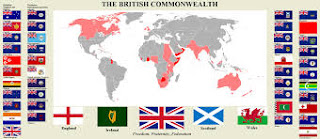The last topic of this first module is the British Empire
during Queen Victoria’s reign which got a very important role in history. I would like you to memorize the main events so that you get a clear overview of the age, together with the literary aspects.
As a definition, an 'empire' is a group of countries ruled
over by a single monarch. But it doesn't need an 'emperor'.
The British
Empire comprised Britain, the 'mother country', and the colonies, which were countries
ruled to some degree by and from Britain.
The British began to establish overseas colonies in the 16th
century. The growth of the British Empire was due mainly to the competition for
resources and markets which existed between England
and her continental rivals, Spain, France, and Holland.
During the reign of Elizabeth I, England set up trading
companies in the East Indies, explored the coast of North America, and
established colonies there.
In the early seventeenth century those colonies
were expanded . By 1783 Britain had a large empire, with colonies in America
and the West Indies. This 'first British Empire' came to an end after the
American Revolution, when the U.S.A got independence.
However, in the 19th century, the British built a second empire, based on British sea-power, India, and huge areas in
Africa.
The 'Whig' historians regarded the Empire as the deserved
result of Britain's superiority. They were proud that
their country had put together such a
huge empire. Some modern historians have criticised Britain's
'cultural imperialism', suggesting that it was based on nationalism and racist
scorn for other people.
After the First World War it became difficult for Britain to
hold on to her Empire. It was clear that
Britain could no longer afford an Empire and had no right to rule
peoples who did not want to be ruled by Britain.
Britain realised that the Royal Navy was not strong enough
to protect all the Empire anywhere in the world.
Ireland rebelled between 1919 and 1921. In 1920‒1921 it was
divided into Northern Ireland, which was part of the UK, and the Irish Free
State. In 1937 it became more independent as Éire. In 1949 Éire became the
completely independent Republic of Ireland and left the Commonwealth.
There was a strong independence movement in India. Mohandas Gandhi led a non-cooperation movement which refused
to obey British laws.
In 1935 the Government of India Act gave Indians control of
everything except foreign policy.
The British Empire was dismantled and replaced by a
voluntary organisation of former colonies called the Commonwealth.
In 1926, the British government agreed the Balfour Declaration
– that Canada, Australia, New Zealand and South Africa were completely
independent countries, "freely associated as members of the British
Commonwealth of Nations".
In 1947, India and Pakistan were given independence.
Most of Britain's African and Caribbean colonies achieved
independence in the 1960s.
In 1997, Britain formally handed Hong Kong back to China.
Until the 1960s, Britain was part of a Commonwealth trading
community based on the Empire.
In 1973, Britain joined the European Economic Community, and
became part of a trading community based on free trade between the countries of
Europe.
See you in class with a new topic to talk about!
Prof
See you in class with a new topic to talk about!
Prof


No comments:
Post a Comment